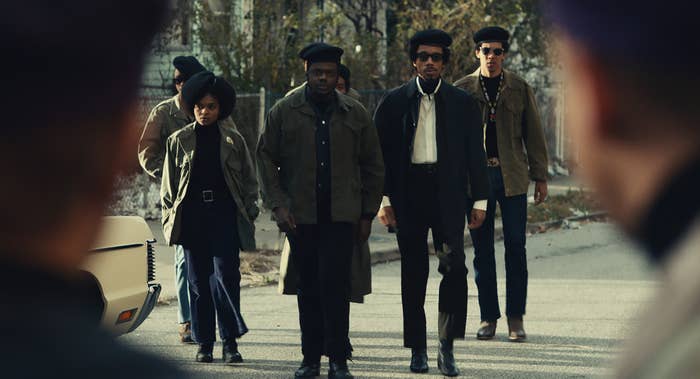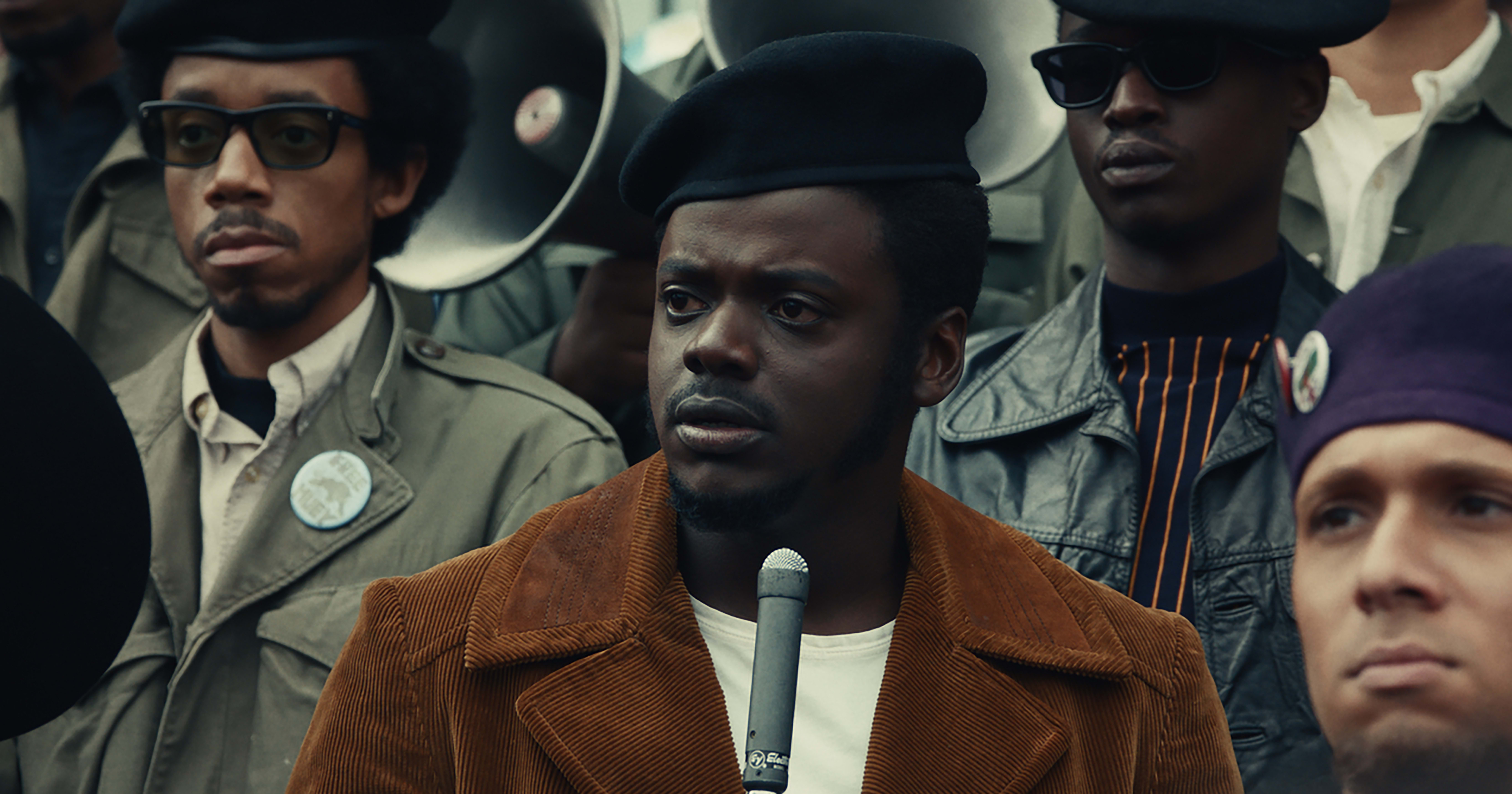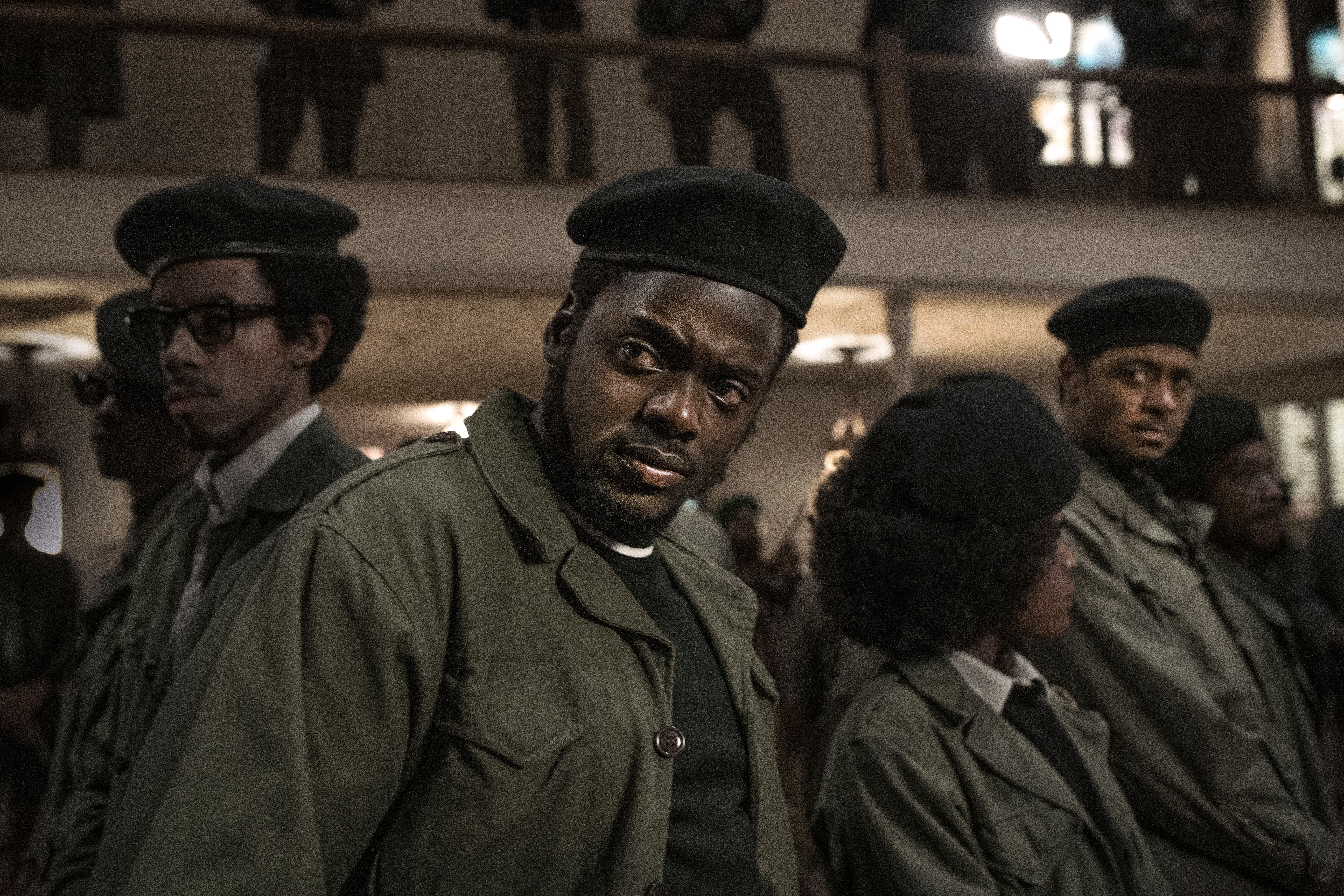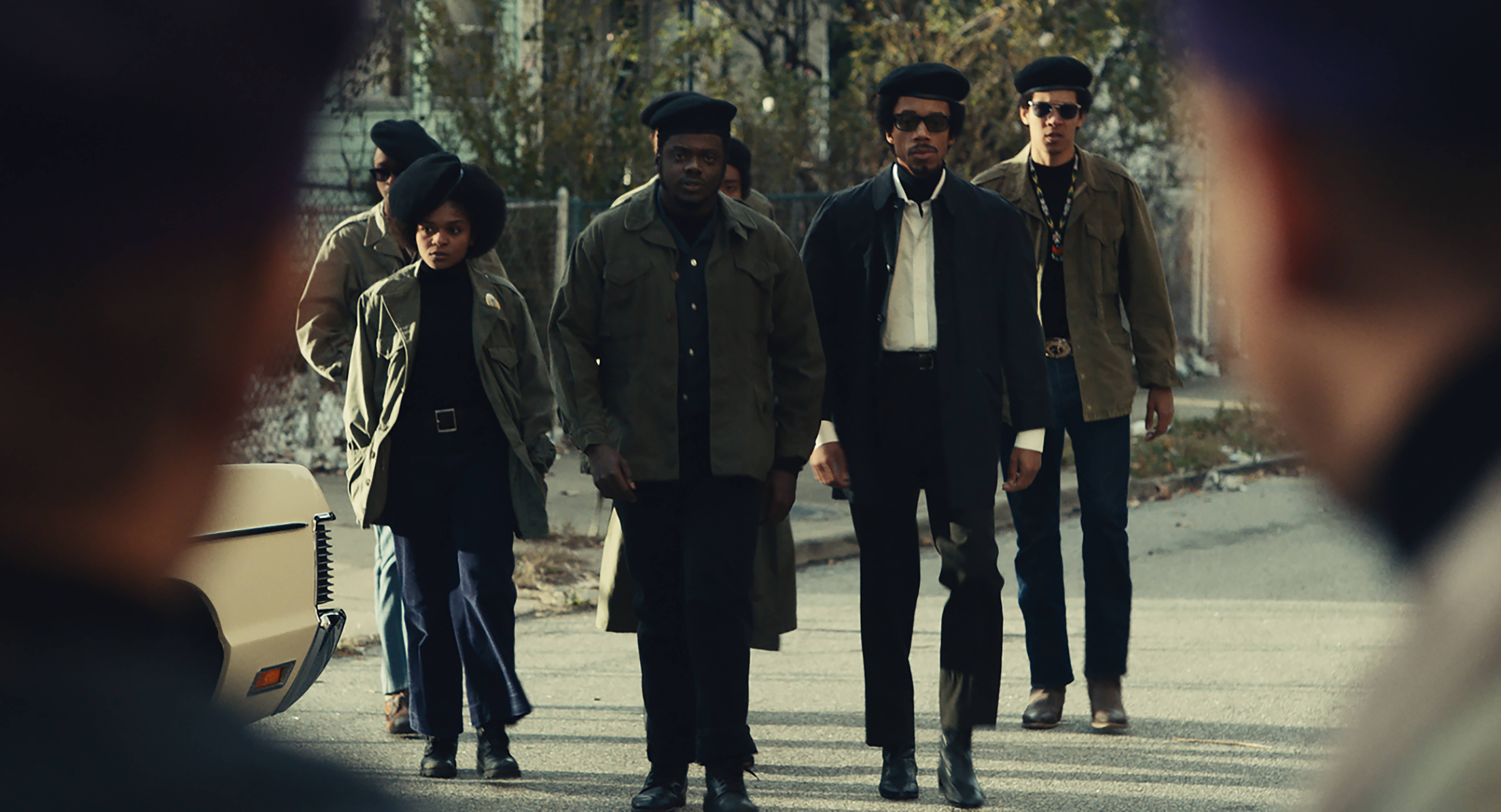
Visually, when you think of the Black Panther Party, the organization founded by Huey P. Newton and Bobby Seale in 1966 that advocated for the protection and uplift of Black communities across the U.S., you think of black berets, leather, and black sunglasses. But despite the organization’s meaningful impact, the look can sometimes feel like a novel costume for anyone who wants to telegraph Black pride and power.
Charlese Antoinette Jones, the costume designer behind Judas and the Black Messiah, a film depicting how FBI informant, William O’Neal, infiltrated the Illinois Black Panther Party and helped in the assassination of its chairman Fred Hampton, wanted to fight against that by being true to the time and capturing the nuances of their attire.
“I think sometimes visually, it’s easy to ignore something if you’re seeing something you’re familiar with,” says Jones. “So, some of the things that were happening could have been lost if they were always there. And I didn’t want it to feel like cosplay either. I wanted it to feel real.”
Jones is familiar with dressing Black characters—she costume directed Netflix projects See You Yesterday, Raising Dion, and Astronomy Club, but there was a historical weight that came with this film, which was also her first studio project.
Here, Jones speaks about how she sourced pieces for this film, the surprising things she learned about the Black Panther Party’s uniforms, and her important side project, the Black Designer Database.
How did you get this job?
The director [Shaka King] and I have been friends and collaborators for over a decade, so when he is working on something, he usually lets me know. He told me about this project probably a year before it actually was greenlit. We talk about projects and things we’re doing all the time, but, with Hollywood, you never know what’s going to go when. But I happened to have already done a show where there were Black Panthers on the show, and so I had some research already done. It just felt really serendipitous. After that, I just kept doing research, and then when it felt like it was getting closer to being a real possibility, I started doing even more research and preparing for an actual interview. And I had the script, so I just dove into the script, researched more about Chairman Fred’s life, and just really learned. And so, when it was time for me to interview, I was ready.
What was your approach with the costumes?
I tried to be as true to the period as possible, because I didn’t want anyone to be distracted by the clothing. I wanted it to feel real and lived-in and just reflective of people’s income, but also beautiful, because Black people are stylish and unique in the way we dress, so you should definitely see differences in different environments.
I used a lot of photos of Chairman Fred [Hampton], of the Patriots, of the Young Lords. And it was about looking at the imagery and bringing down exactly what people were wearing, finding those pieces and re-creating looks pretty close in silhouette, if not exactly the same look.

Where did you source the looks?
The best way to accomplish this was working with a lot from costume houses in LA, and then sourcing clothing on the ground in Cleveland where we were shooting. We were sourcing clothing in Cleveland and in Cincinnati. My shopper, Lisa, was going all around Ohio all the time to different flea markets and antique markets. I also took a trip out to Fresno, Ohio to a dealer who basically had bought out a couple of department stores. He had giant bins of jeans, sweaters, and leather jackets that were pristine and from the ‘60s. It was insane. PF Flyer sneakers for little kids still in the box. It was an amalgamation.
There were some things we built as well and we recreated them from photographs or video footage. So, we rebuilt the piece for O’Neal for the Eyes on the Prize interview. We built that suit. We built Deborah’s robe, the night of the raid. Chairman Fred’s boxers were built. And then a couple other pieces for a couple other characters, just as needed, creatively.

I liked the look when Fred Hampton wore the camo bucket.
He wore that in a documentary that I watched. And, then it was like, OK, where’s that camo from? And I did the research, and I went to a costume house in LA where they specialize in military gear. I showed them images and they looked through their archives. It ended up being a duck camo hunting cap, which makes sense. Because he was very utilitarian. He was also a former athlete. He wore clothes that were very functional.
What was the biggest challenge with the project?
Time. It was under the gun the entire time. We were fitting people till damn near the end. You just have to have a really good team, and I did, and the team wasn’t as big as it could’ve been, but we made it work. Costume design involves so many people, and it’s really a team effort. Filmmaking period is.
But I had to approve every single thing. I had to look at every single thing every single person wore and approve it, including the background, because it was that serious. It was that specific, and I just had a really clear vision how I wanted it to go. And it might’ve annoyed people, because some people are used to working and the costume designer doesn’t care what the background wears. I was like, “No, no, no, you’re going to be able to see everybody.”

We know the Black Panther uniform as the black beret and leather. But were there any new things that you learned? I noticed in one scene how the different organizations had different beret colors.
The different colored berets were different colored organizations of gangs. So The Crowns, which are based off of a real organization, wore green berets and the Young Patriots wore the coyote brown berets, and the Young Lords wore purple berets. So, every group had their own color. There’s also the Red Guard, which was an Asian organization that also wore a specific colored beret. I started to see how the Panthers inspired these other groups to pop up as well, and some of them were former gangs that ended up becoming revolutionary organizations.
The other thing about the Panthers was just the regional differences between the Chicago or Illinois chapter and the Oakland headquarters. And in a lot of images I found of the Illinois party, they were wearing these camo green army jackets, and they weren’t wearing a lot of leather. I even have images of them in the snow in these jackets, and I just thought that was fascinating. And me and the director talked about that early on, how we wanted to make sure they felt like and had individuality in that way, and present something different. Because also, I think sometimes visually, it’s easy to ignore something if you’re seeing something you’re familiar with. So, some of the things that were happening could have been lost if they were always there. And I didn’t want it to feel like cosplay either. I wanted it to feel real. So, in most of the images we saw, they were wearing camo green jackets, and then we did find some images of them wearing mostly leather, so that’s why towards the end of the film, we start seeing more leather being present. But earlier on, it’s more about the camo green jacket.
And the reasoning behind that had to do with the protesting of the draft and the Vietnam War and just signifying the fact that there was a war happening here, against Black people. And then the significance behind the beret is Huey P. Newton said that it was the international symbol of revolutionaries, so he was like, revolutionaries in Third World countries around the world wore berets when they were fighting.
Another thing I learned, everybody thought they wore sunglasses and the jackets and the berets to look cool, and actually, it was about concealing identity from the cops. That was the other thing that I learned. And Fred Jr. was great. He taught me a lot of this stuff.

Let’s talk about your Black Designer Database.
It kind of happened organically. Since I’ve started styling and fashion designing, I’ve compiled lists of indie designers and Black designers in my own spreadsheet. I used Black designers on both See You Yesterday and Raising Dion. I felt like I needed to find new talent when I was starting this comedy sketch show called Astronomy Club on Netflix because the cast wanted to wear all Black designers. So I posted on my Facebook asking people to post Black designers, and within the first 24 hours I had 100 entries, and they were people I had never heard of. People wanted me to make the list public, which I intended to do, and then when the pandemic hit and Black Lives Matter became an international focus, and George Floyd passed, and Breonna Taylor was killed, all this trauma was happening, and I couldn’t focus to finish the database.
And at the same time, I saw all these people popping up with solutions that were kind of like what I was doing, and I was like, hm, do I really need to do this still? And then I was like, you know what, finish what you started. So, I just finished it. And my perspective was always about product placement and connecting designers to costume designers, because that’s what I have been doing this whole time, and that’s my network. It went live on Black Friday in November. And then our launch-launch is actually this month, Black History Month, and InStyle did an amazing write-up about us. And we’ve been curating lists because non-Black people would hit me up asking me for Black designers because they weren’t tapped into the community that way. But they might be designing something where Black designers would be amazing for it. Or they just really want new talent. So, part of what we do is curate lists for fellow designers. They can send us their mood boards under complete confidentiality, and we curate lists for them. And then the actual database is live, and it’s available to the public. Anybody can go on and search by category or by city, and that’s free.
Were you able to utilize any Black designers for this film?
Yes. I actually used a crochet artist, Nassat Nation by Nacinimod, to make a crocheted vest for one of our actresses, and you see it towards the end of the film. The night before the raid and they’re all at Chairman Fred’s home. So, I contacted him, and I believe I sent him the vest and then told him… I sent him the colors, and he knocked it out so fast. He did a couple of them for me. So, yeah, I did. I think he might be the only one I was able to use in the film. Yeah. I think so. It’s amazing, because it’s a handmade vest.
So, what’s next?
I am figuring that out. It’s like, what do you take after a project like this? And I’ve had some opportunities. I’ve done a couple of small jobs, commercials here and there and stuff like that. But, yeah, I’m not really sure what film is next for me. I definitely am working on my personal projects, like developing the Black Designer Database more. I have been working on a project for years now telling the story of my aunt. She had a landmark sexual harassment case that is the basis for the sexual harassment laws we have to this day. And so, I’ve been working with a producer friend on that, and it looks like it might gain some momentum soon, so that’s cool. I have my brand, Char Ant Gold. So, I’m constantly doing custom things for various clients and things like that.

